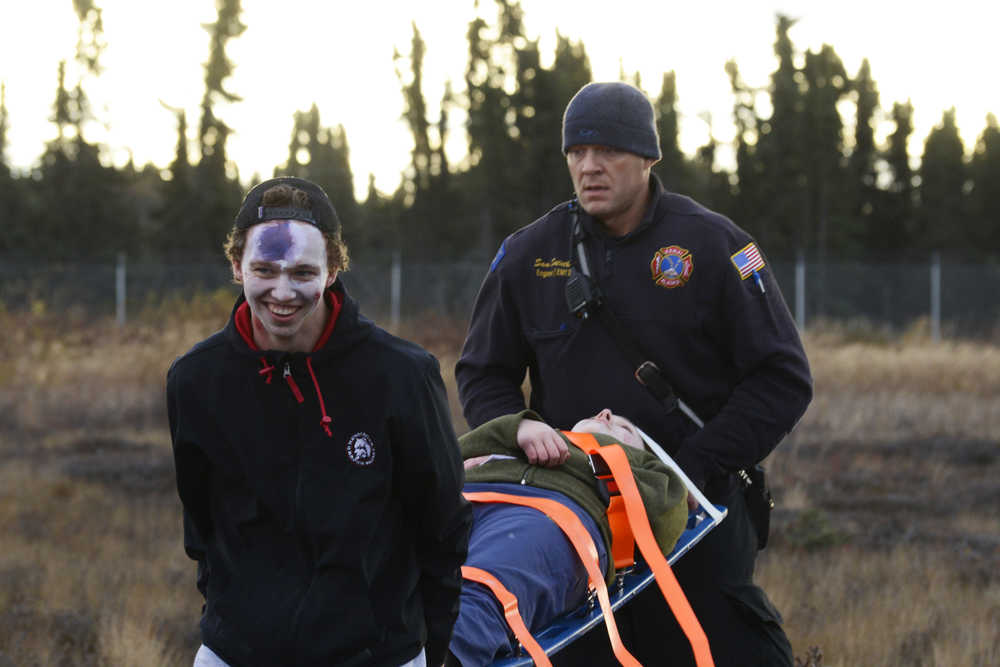Bailey Seagraves reclined as comfortably as he could into the moss and brambles in a marshy field at the Kenai Municipal Airport, his sweatpants, crew neck and sneakers the only things shielding him from the sharp Tuesday morning air. Above him, a firefighter in protective gear doubled back, leaned over him and checked the color coded card attached to his wrist.
“Oh, you’re dead,” the firefighter said before moving on through the field.
Seagraves, whose white face paint added to his ghostly appearance, joined more than 30 other volunteers to pose as plane crash victims and medics during a mass casualty simulation required of the airport by the Federal Aviation Administration every three years. The simulations help first responders and airport staff stay up to date on their reaction plans in the case of an emergency, said Airport Manager Mary Bondurant.
“Annually we have a tabletop review of our emergency control plan, and then every three years we conduct a mock mass casualty exercise,” she said.
The airport’s last simulation was a plane crash into water. This time, Kenai Fire Chief Jeff Tucker said firefighters had to respond as if a 30-passenger Dash 8 plane — the largest capacity aircraft that regularly uses the Kenai airport — had crashed during takeoff.
In a mass casualty situation at the airport, the call first goes to the watch tower, where Bondurant said employees pick up a red phone to start the chain of command. The Kenai Fire Department responds while mutual aid calls go out to the Nikiski Fire Department and Central Emergency Services. Kenai’s city manager and Bondurant are also notified.
“We had great cooperation from our neighboring departments,” Tucker said of Tuesday’s drill.
In order to make the scenarios realistic, the responding agencies put out a call to community volunteers. Several members of the Kenai River Brown Bears hockey team turned out this year, as well as area residents and those currently enrolled in emergency medical technician or paramedic courses.
Seagraves, a Brown Bears player from Columbus, Ohio, said he thought the drill would be a good way to get out into the community and that it was “cool to see this side of things.” He and other victim volunteers were given white and red face paint to simulate injuries — some even had fake intestines hanging out of their shirts while they waited to be rescued.
Each victim was color coded. Red patients were in the most serious condition, basically “the most critical before they’re dead,” according to Logan Howlett, a current EMT 3 who is enrolled in a paramedic course and volunteered to help with one of the medic stations inside the airport’s operation center where victims were brought by ambulance. He and Brendan Blossom, an EMT 1, were stationed at a red tarp to tend to incoming patients. Blossom said the learning experience would be a good one since mass casualties are rare in the area.
“I’m new … so I’ve never experienced anything like this, just having patients come in and just treating them quick and getting them transported,” he said.
Other volunteers were coded green or yellow for varying degrees of injury, and those who were coded black were already dead.
“When they (the firefighters) ask you for a pulse and all that since they can’t check you, (we were told) just to tell them ‘no,’” Seagraves said of the code black volunteers.
Volunteers Beth Pingree of Soldotna and Keagan Whitcomb of Nikiski are enrolled in an EMT 1 class, but opted to pose as crash victims rather than work on patients in the operation center. The pair said they were excited before heading out to the crash site Tuesday, both as high priority patients. Whitcomb smiled at the prospect while a fake piece of rubble stuck out from her neck.
“I really wanted to do the patient side of it because I wanted to see what it was like from the other side,” Pingree said. “What does the patient go through when something like this happens?”
First responders and airport personnel debrief after the simulation, Bondurant said, to figure out what to work on for next time or if anything in the airport’s emergency plan needs updating.
“We always learn something and always pick up something we can do better,” Tucker said.
Communication was cited this year, and most years, as something that can always be improved, Bondurant said. Whether it’s the equipment or the words being used, someone usually speaks up with a small issue during the debriefing, she said.
“The only other thing that came up during the debrief was … possibly having a second set of triage kits,” Bondurant said.
Having a second kit would allow more triage work to be done in the field versus waiting until patients are back at the operations center, she said.
Once the triennial drills are complete, members of the FAA can request to see files on them when they come to the airport for inspections, Bondurant said. The scenarios get switched up from drill to drill to incorporate things like water landings and other disaster possibilities the airport would need to be ready for, she said.
“It just gets everybody going and thinking about if this is happening, we want to put our best foot forward,” she said.
Reach Megan Pacer at megan.pacer@peninsulaclarion.com.

